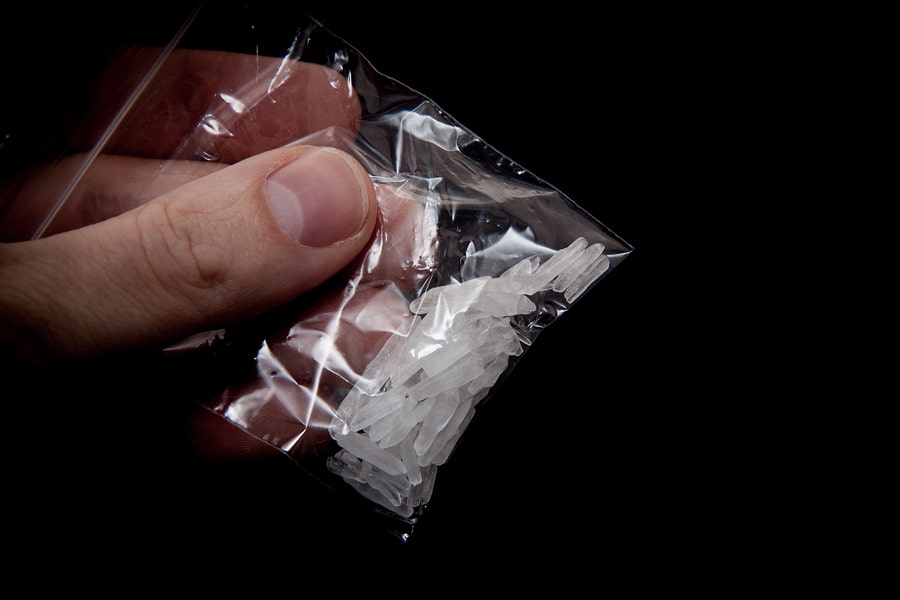When it comes to methamphetamine—the drug commonly known as meth—there are plenty of misconceptions out there. Many people wrongly assume it’s just another illegal drug, like marijuana, Cocaine Base (“crack”) or heroin. The truth is, meth is in a category all its own with devastating side effects, both short-term and long-term.
The Effects of Meth
An extremely addictive drug that affects the nervous system, meth is known to give users a rush of energy that leaves them immediately wanting more. The chemical dopamine floods the parts of the brain that controls feelings of pleasure—so users experience a burst of energy and confidence, creating a state of euphoria that can last about 30 minutes. With its ability to trigger such positive feelings, it’s no wonder meth is such a highly addictive drug.
Physical Changes
After using the drug, meth users also experience some serious physical symptoms, which can cause physical changes to the looks of a person and may include:
- Hyperthermia—a drastic rise in body temperature, which can lead to unconsciousness or death
- Increased respiration rate
- Dilated pupils
- Severe hypertension
- Decreased appetite and weight loss
- Nausea
- Convulsions and seizures that can lead to death
Short-Term Effects
The immediate euphoric sensation drug users experience after using meth is a short-lived feeling that gives way to a “crash”—a physical and mental breakdown.
Beyond the physical symptoms triggered by meth use, drug users can expect a range of negative psychological side effects, including hyperactivity, delusions of power, aggressive or violent behavior, irritability, hallucinations, anxiety, paranoia and psychosis.
Long-Term Effects
Since the short-term effects of using meth are so severe, it doesn’t take long for the drug to take its toll on a person, giving way to devastating long-term effects.
Physically, meth users will appear to age more quickly as the drug destroys tissues and blood vessels, preventing the body from healing as it naturally should. As a result, the skin loses its elasticity, giving it a dull look. Users often develop severe acne as well. One of the most pronounced physical effects of long-term meth use, though, is rapid and severe tooth decay, also known as “meth mouth.”
Aside from changes in physical appearance, long-term meth abuse can cause damage to blood vessels of the heart and brain, and high blood pressure, which can lead to heart attacks or strokes. Other long-term effects include kidney, lung and liver damage, as well as brain damage similar to Alzheimer’s disease.
The long-term psychological effects of meth are also extremely dangerous. Meth users tend to develop persistent psychotic symptoms, including delusions, hallucinations and paranoia. As they become increasingly dependent on the drug, mental health issues, such as depression, anxiety and feelings of isolation, are also more likely to arise.
Over time, users will experience the sensation of bugs crawling on them—causing them to pick at their skin obsessively, which creates sores, notably on the face.
Disorders Caused by Meth
Long-term meth use can lead to a range of disorders as the drug causes structural and functional changes in the brain. These disorders include:
- Depression
- Psychosis
- Anxiety
- Parkinson’s disease
According to the Delta Medical Center, users often exhibit symptoms of depression, psychosis and anxiety before meth use, but the drug exacerbates those symptoms. Up to 46% of regular meth users report meth-induced psychosis, while 75% of users report symptoms of anxiety. Depression, meanwhile, is the most common co-occurring mental health disorder seen in meth users, with 40% of adults who use amphetamines reporting a lifetime history of depression.
Recent research shows that heavy meth use also highly increases the risk for Parkinson’s disease, a degenerative neurological disorder that severely hinders one’s ability to control muscle movement.
Meth vs. Other Drugs
Meth may have effects similar to those of other drugs, but it still remains one of the most dangerous and destructive illegal substances out there. Below are comparisons of how meth stacks up against other illegal drugs.
Meth vs. Ice
Ice is simply another common street word for meth. Both are methamphetamines. The effects are the same.
Meth vs. Cocaine Base or “Crack”
While both meth and crack are stimulants, meth produces a high that can last for up to 16 hours longer than crack, which is a freebase form of cocaine that can be smoked. The effects of meth last longer because crack leaves the body much faster than meth does—half of crack leaves the body within an hour, while half of meth leaves the body within 12 hours. Crack is also a local anesthetic that provides a numbing sensation—unlike meth, which is only a stimulant.
Meth vs. Speed
Meth and speed (which is an amphetamine) are often confused with each other. While they are similar in many ways, the drugs do also have critical differences. Amphetamine is used in some prescription medications, while meth is used solely recreationally.
Both drugs can cause a rapid heart rate and increased metabolism, but meth is more likely to cause symptoms such as impaired speech, a rapid pulse, shallow breathing, dizziness, and insomnia, among other negative effects. While meth and speed have similar side effects, the effects of meth are usually much stronger and tend to happen more quickly than with amphetamine use.
Meth vs. Molly
A common misconception is that molly is the pure form of MDMA or “Ecstasy”. According to the Drug Enforcement Administration (DEA) in 2014, only 13% of molly seized in New York State actually contained MDMA, and that 13% wasn’t pure MDMA, either!
Pure MDMA is expensive. Meth is not. So rather than using the pure form of MDMA, drug dealers concoct a cheaper mixture and market it as molly, and meth is one of the most common drugs found in molly.
The bottom line: If you buy molly, you can reasonably assume you’re about to use meth.
Meth vs. Marijuana
To compare meth with marijuana is a lot like comparing apples to oranges. They simply don’t belong in the same category of drugs.
Because marijuana plants have been found to have healing properties, 25 U.S. states and Washington D.C. have legalized medical marijuana.
Physical effects of marijuana can include increased heart rate, dizziness, dry mouth, increased appetite and a slowed reaction time. Some negative effects include loss of productivity and rare cases of drug-induced psychosis. While marijuana does have addictive properties, it isn’t nearly as addictive or harmful as meth.
Beware of Meth
No matter how you look at or compare it, there’s no denying meth is an extremely addictive and dangerous drug. Its immediate euphoric effects keep its users coming back for more, but at an incredibly high cost that negatively impacts their physical health, their mental well-being, and in many cases, their lives.
If you’ve been charged with possession of meth or another drug offense in South Carolina, speak with an attorney to help you understand and navigate the legal process of your charge. Contact the offices of Russell Hilton at 843-376-5524, or message us directly.



